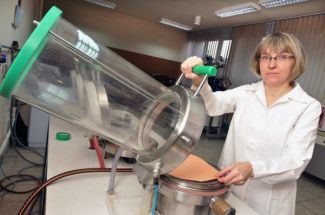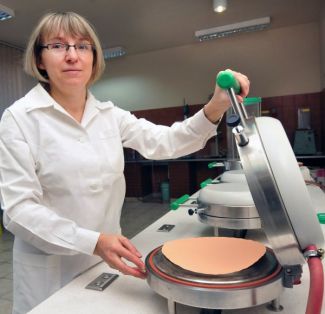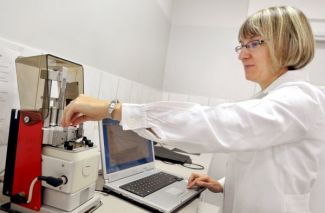Product packaging is supposed to be functional and aesthetically pleasing but it also needs to protect the contents. This is particularly important in the case of food packaging as food requires special protection. Lodz University of Technology scientists have been working on developing environmentally-friendly packaging that will provide full protection of products. Dr inż. Janina Leks - Stępień of the Institute of Papermaking and Printing speaks about her research on biodegradable barrier coatings for paper packaging materials.
What are barrier properties and what do they apply to?

Barrier properties are generally described as the capacity for limiting packaging permeability to liquids, vapours and gases. At the Institute of Papermaking and Printing, we have been investigating barrier properties of paper packaging materials mainly with regard to chemical substances. They can be found in packaging materials, both non-printed but ready for use as well as printed with ink or varnished. As far as paper packaging goes, the quality of materials used for their manufacturing is a determining factor in deciding their safety. Barrier properties are especially significant with regard to food packaging as food requires special protection.
Could paper packaging be unsafe?
The quality of paper, and therefore of the packaging, depends to a large extent on the type of pulp it is composed of and on the method of production of fibre intermediates. When paper is made from virgin cellulose fibres, this hazard hardly figures. It does figure, however, for packaging made from recycled paper. Risk arises when processes of recovery of raw materials to be used in packaging are performed inadequately (e.g. left-over ink, glue or varnish from the previous product life-cycle that have not been sufficiently removed). I would like to emphasise that most of the potential contaminants in recycled paper are effectively removed in the process of its treatment and they do not pose a health hazard for consumers.
What other materials, besides paper, are investigated during the project carried out at TUL?

Together with the Department of Man-Made Fibres, Faculty of Material Technologies and Textile Design, we have been working to develop a fully biodegradable barrier coating. We want to use biodegradable polymers such as, for example, regenerated cellulose to coat the surface of the paper (including recycled paper). The coating that we have been working on will not only be 100% biodegradable but will also provide a barrier and protect the product.
Please, tell us about the research done at TUL.
At the Institute of Papermaking and Printing, we can separate different types of cellulose, chemically from wood, as well as recycled paper. The pulp is then processed into paper which is subsequently refined by coating its surface to obtain the desired performance properties. The resulting material is then tested and investigated with reference to the research objectives.
Analytical methods are key in examining suitability of packaging materials for food contact. They make it possible to identify potential migrating substances and contaminants in packaging materials and the way the exert their toxic impact, the level of additives in materials that come into direct contact with food and to determine the maximum dose levels of contaminants in packaged food. The primary criterion for assessment of suitability of packaging materials for food contact is the migration of potentially hazardous substances. Chemical compounds such as bisphenol, pentachlorophenol, Michler's ketones significantly increase health hazards for consumers. They can only be detected by detailed chemical analyses that make it possible to determine whether the barrier coating has done its job and we can be sure that the products we consume do not impact our health negatively. We examine factors that influence migration of contaminants, we analyse the conditions and the course of the coating process and modify the composition of the coating so that the barrier would do its job.
How are the coatings innovative?

The primary aim of innovation is to obtain high barrier properties and to reduce environmental impact by using environmentally friendly materials. The coatings that we have been working on are based on unmodified natural polymers and natural polymers modified by biotechnological methods or by chemical synthesis. These coatings are expected to provide a protective barrier owing to which the packaging will undergo complete, natural and quick biodegradation.
How does paper packaging compare to other types of packaging?
These days, as we are growing increasingly aware of the importance of sustainable development, environment protection is more and more significant, which causes changes in the requirements that product packaging needs to meet.
Paper packaging has long been considered safe for food products - just think of paper tea, flour or sugar bags. The strong interest in paper packaging mainly stems from the fact that they are manufactured from renewable resources, they are lightweight, non-breakable, easy to use, easily accessible, have excellent quality of print and are stackable. Used paper packaging can be recycled or utilised. Thus, as far as ecology is concerned, they are a substitute for packaging made from synthetic materials.
When can we expect any results?

The results of the research conducted at Lodz University of Technology have been very satisfying and it appears that quite soon we should have production-ready biodegradable packaging that is completely safe for the contents. Its cost will not be the decisive factor. Our society has become more demanding and that is why I think that the awareness of reduced environmental impact, and, above all, health safety, should offset the price increase.
What will this packaging look like?
I think it will not be different from the packaging we are used to today. You cannot see the barrier coating. It is transparent. You can print on it and perform all the operations that are performed on standard packaging made from paper or synthetic materials. It will be possible to use this packaging wherever there is a need for a barrier coating.
Can we feel safe buying products in paper packaging?

Yes. Standards and regulations applicable to finished packaging materials on the one hand and consumers on the other require of manufacturers more and more transparency with regard to what the packaging is made of and how it is made. Therefore, we can feel safe buying products packed in paper packaging.
It is worth being a scientist because...
... you can answer the questions 'How?', 'Why?', 'In what way?', 'Thanks to what?' I expand my knowledge and I hope to be able to find answers to questions that have aroused my curiosity. Of course, one answer generates another question and this is exactly what I find so fascinating, inspiring and rewarding.
